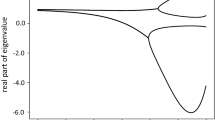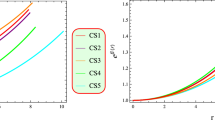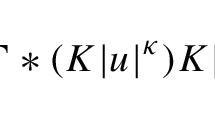Abstract
Truncating at the second order of the mutual potential between two rigid bodies, time-explicit first order solutions to the rotations and the orbital motion of the two bodies in the planar full two-body problem (F2BP) are constructed. Based on this analytical solution, equations of motion (EOMs) for the related restricted full three-body problem are given. In the case of the synchronous or double synchronous states for the full two-body problem, EOMs for the related restricted full three-body problem (RF3BP) are also given. At last, one example—the “collinear libration point” in the binary asteroid system—is given.
Similar content being viewed by others
Change history
11 February 2022
A Correction to this paper has been published: https://doi.org/10.1007/s42064-022-0136-2
References
Duboshin, G. N. The differential equations of transitional-rotational motion of mutually attracting rigid bodies. Soviet Astronomy, 1958, 2: 239–250.
Borderies, N. Mutual gravitational potential of N solid bodies. Celestial Mechanics, 1978, 18(3): 295–307.
Maciejewski, A. J. Reduction, relative equilibria and potential in the two rigid bodies problem. Celestial Mechanics and Dynamical Astronomy, 1995, 63(1): 1–28.
Scheeres, D. J. Rotational fission of contact binary asteroids. Icarus, 2007, 189(2): 370–385.
Paul, M. K. An expansion in power series of mutual potential for gravitating bodies with finite sizes. Celestial Mechanics, 1988, 44(1–2): 49–59.
Ashenberg, J. Mutual gravitational potential and torque of solid bodies via inertia integrals. Celestial Mechanics and Dynamical Astronomy, 2007, 99(2): 149–159.
Tricarico, P. Figure–figure interaction between bodies having arbitrary shapes and mass distributions: A power series expansion approach. Celestial Mechanics and Dynamical Astronomy, 2008, 100(4): 319–330.
Compère, A., Lamaȋtre, A. The two-body interaction potential in the STF tensor formalism: An application to binary asteroids. Celestial Mechanics and Dynamical Astronomy, 2014, 119(3–4): 313–330.
Hou, X. Y., Scheeres, D. J., Xin, X. Mutual potential between two rigid bodies with arbitrary shapes and mass distributions. Celestial Mechanics and Dynamical Astronomy, 2017, 127(3): 369–395.
Wang, L.-S., Krishnaprased, P. S., Maddocks, J. H. Hamiltonian dynamics of a rigid body in a central gravitational field. Celestial Mechanics and Dynamical Astronomy, 1991, 50(4): 349–386.
Scheeres, D. J. Stability in the full two-body problem. Celestial Mechanics and Dynamical Astronomy, 2002, 83(1–4): 155–169.
Koon, W.-S., Marsden, J. E., Ross, S. D., Lo, M., Scheeres, D. J. Geometric mechanics and the dynamics of asteroid pairs. Annals of the New York Academy of Sciences, 2004, 1017: 11–38.
Cendra, H., Marsden, J. E. Geometric mechanics and the dynamics of asteroid pairs. Dynamical Systems: An International Journal, 2005, 20(1): 3–21.
Scheeres, D. J. Relative equilibria for general gravity fields in the sphere-restricted full 2-body problem. Celestial Mechanics and Dynamical Astronomy, 2006, 94(3): 317–349.
Boué, G., Laskar, J. Spin axis evolution of two interacting bodies. Icarus, 2009, 201(2): 750–767.
Hirabayashi, M., Scheeres, D. J. Recursive computation of mutual potential between two polyhedral. Celestial Mechanics and Dynamical Astronomy, 2013, 117(3): 245–262.
Naidu, S. P., Margot, J.-L. Near-Earth asteroid satellite spins under spin-orbit coupling. The Astronomical Journal, 2015, 149(2): 80–90.
Boldrin, L. A. G., Scheeres, D. J., Winter, O. C. Dynamics of rotationally fissioned asteroids: Nonplanar case. Monthly Notices of the Royal Astronomical Society, 2016, 461(4): 3982–3992.
Scheeres, D. J. Stability of the planar full 2body problem. Celestial Mechanics and Dynamical Astronomy, 2009, 104(1–2): 103–128.
Jacobson, S. A., Scheeres, D. J. Dynamics of rotationally fissioned asteroids: Source of observed small asteroid systems. Icarus, 2011, 214(1): 161–178.
Gabern, F., Koon, W. S., Marsden, J. E. Spacecraft dynamics near a binary asteroid. Discrete and Continuous Dynamical Systems, 2005, Supplement Volume: 297–306.
Gabern, F., Koon, W. S., Marsden, J. E., Scheeres, D. J. Binary asteroid observation orbits from a global dynamical perspective. SIAM Journal on Applied Dynamical Systems, 2006, 5(2): 252–279.
Bellerose, J., Scheeres, D. J. Restricted full three-body problem: Application to binary system 1999 KW4. Journal of Guidance, Control, and Dynamics, 2008, 31(1): 162–171.
Chappaz, L., Howell, K. C. Exploration of bounded motion near binary systems comprised of small irregular bodies. Celestial Mechanics and Dynamical Astronomy, 2015, 123(2): 123–149.
Hou, X., Xin, X., Tang, J., Liu, L. Dynamics around libration points in the binary asteroid system. In: Proceedings of the 25th International Symposium on Space Flight Dynamics, 2015.
Woo, P., Misra, A. K. Bounded trajectories of a spacecraft near an equilibrium point of a binary asteroid system. Acta Astronautica, 2015, 110: 313–323.
Hussmann, H., Oberst, J., Wickhusen, K., Shi, X., Damme, F., Ludicke, F., Lupovka, V., Bauer, S. Stability and evolution of orbits around the binary asteroid 175706 (1996 FG3): Implications for the MarcoPolo-R mission. Planetary and Space Science, 2012, 70(1): 102–113.
Yu, Y., Schwartz, S. R., Michel, P. Dynamics of ejecta from a binary asteroid impact in the framework of AIDA mission: A NEOShield-2 contribution. In: Proceedings of the European Planetary Science Congress, 2015.
Kinoshita, H. First-order perturbations of the two finite body problem. Publications of the Astronomical Society of Japan, 1972, 24: 423–457.
Balmino, G. Gravitational potential harmonics from the shape of a homogeneous body. Celestial Mechanics and Dynamical Astronomy, 1994, 60(3): 331–364.
Szebehely, Z. Theory of Orbits. New York: Academic Press, 1967.
Hou, X. Y., Liu, L. On quasi-periodic motions around the collinear libration points in the real Earth–Moon system. Celestial Mechanics and Dynamical Astronomy, 2011, 110(1): 71–98.
Jorba, A., Masdemont, J. Dynamics in the center manifold of the collinear points of the restricted three body problem. Physica D: Nonlinear Phenomena, 1999, 132(1–2): 189–213.
Gómez, G., Masdemont, J., Simó, C. Quasihalo orbits associated with libration points. Journal of the Astronautical Sciences, 1999, 46(2): 135–176.
Masdemont, J. J. High-order expansions of invariant manifolds of libration point orbits with applications to mission design. Dynamical Systems: An International Journal, 2005, 20(1): 59–113.
Bellerose, J., Scheeres, D. J. Stability of equilibrium points in the restricted full three-body problem. Acta Astronautica, 2007, 60(3): 141–152.
Sharma, R. K., Taqvi, Z. A., Bhatnagar, K. B. Existence and stability of libration points in the restricted three-body problem when the primaries are triaxial rigid bodies. Celestial Mechanics and Dynamical Astronomy, 2001, 79(2): 119–133.
Woo, P., Misra, A. K. Equilibrium points in the full three-body problem. Acta Astronautica, 2014, 99: 158–165.
Shang, H., Wu, X., Cui, P. Periodic orbit sin the doubly synchronous binary asteroid systems and their applications in space missions. Astrophysics and Space Science, 2015, 355(1): 69–87.
Hou, X. Y., Liu, L. On quasi-periodic motions around the triangular libration points of the real Earth–Moon system. Celestial Mechanics and Dynamical Astronomy, 2010, 108(3): 301–313.
Murray, C. D., Dermott, S. F. Solar System Dynamics. Cambridge: Cambridge University Press, 1999.
Ferraz-Mello, S. Canonical Perturbation Theories-Degenerate Systems and Resonance. Springer Science & Business Media, 2007.
Howell, K. C., Pernicka, H. J. Numerical determination of Lissajous trajectories in the restricted threebody problem. Celestial Mechanics and Dynamical Astronomy, 1987, 41(1–4): 107–124.
Acknowledgements
This work was supported by National Natural Science Foundation of China (Grant Nos. 11322330 and 11673072) and National Basic Research Program of China (Grant No. 2013CB834100).
Author information
Authors and Affiliations
Corresponding author
Additional information
Xiyun Hou received his Ph.D. degree in astronomy from Nanjing University, China, in 2008. Now he is a professor at the School of Astronomy and Space Science of Nanjing University. His research interest focuses on the intersection of celestial mechanics and astrodynamics. Currently, he is doing research related to asteroids, including the dynamical evolution of these natural bodies, and the orbital dynamics of the probe or particles around them.
Xiaosheng Xin received his Ph.D. degree in astronomy from Nanjing University, China, in 2017. His research interest focuses on astrodynamics, especially the orbital dynamics of spacecraft or natural bodies around asteroids.
Rights and permissions
About this article
Cite this article
Hou, X., Xin, X. A note on the full two-body problem and related restricted full three-body problem. Astrodyn 2, 39–52 (2018). https://doi.org/10.1007/s42064-017-0010-9
Received:
Accepted:
Published:
Issue Date:
DOI: https://doi.org/10.1007/s42064-017-0010-9




